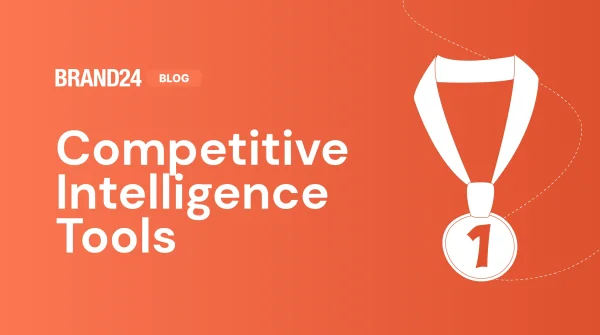How to Use Media Intelligence to Drive Growth in 2025
Tabela de conteúdo
Neon Panda, a beverage brand from Mexico, uses media intelligence to spot cultural trends, tailor their messaging, and make better product decisions. Using a media intelligence solution, they identified the “natural hydration” trend before it peaked and used it to their advantage. Want to know how media intelligence can improve your team? This article is your guide to turning data into action using media intelligence.
Vamos começar!
Resumo rápido:
– Media intelligence means gathering and analyzing data from sources such as news websites, social media, blogs, and forums to understand what people are saying about your brand, competitors, and industry.
– It’s a flexible tool that helps different teams (like PR, marketing, customer service, and leadership) make smarter decisions, spot trends early, manage reputation, and stay ahead of competitors.
– AI can make things easier by quickly summarizing data, analyzing sentiment, finding important voices, and creating reports, so you get useful insights without doing all the manual work.
What is media intelligence? Definition
Media intelligence is the process of gathering and analyzing information from media sources, like news sites, social media, forums, and blogs.
All to gain insights about your brand, competitors, customers, and industry trends.
You can think of media intelligence as a radar.
It continuously scans the digital world to help you find:
- A sudden surge in brand mentions
- A PR crisis
- Viral customer feedback in the online news
- A competitor’s new campaign
Isso ajuda você spot threats early, catch opportunities faste steer your brand with confidence.
Try media intelligence now!
Plus, nowadays media intelligence tools have many built-in AI features that can conduct robust data analysis for you.
You get ready-to-use actionable insights and can skip the whole mundane work of counting numbers.
Take AI Insights, for example, a feature by Brand24, a media intelligence tool, definitely worth considering.
It analyzes the data related to your media monitoring data and presents a quick summary and ideas for improvements.
“AI Insights and the use of the AI assistant within the tool allow us to quickly detect patterns without having to review each mention manually.“
Eduardo Villalobos, Digital Director at Neon Panda
Interesting? Read more about how Neon Panda used Brand24 for media intelligence.
For this article’s purposes, I created a media monitoring project for IKEA, so I can show you the analysis process based on a real-life example.
Here’s what AI Insights looks for IKEA:
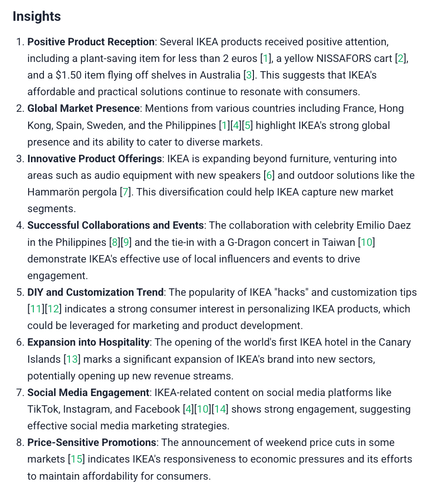
So, IKEA could potentially use the growing interest in customization and DIY trends.
Access AI Insights for your brand!
But, as I mentioned before, media intelligence is a complex term. And it’s much more than just social media monitoring or artificial intelligence features.
Confused?
Let me briefly introduce you to the most important parts of the media intelligence solutions.
Key elements of media intelligence:
- Data from all the right places
Media intelligence starts with data collection from everywhere your brand might be mentioned – social media, news, media outlets, blogs, forums, podcasts, and even traditional media. - Monitoramento de mídia em tempo real
You need to know what’s being said about your brand the moment it happens. Ferramentas de monitoramento de mídia help you catch breaking news, viral posts, or a potential Crise de relações públicas before it escalates. - Análise de sentimento
It’s not just what people say, but also how they feel about it. Análise de sentimento helps you gauge whether the buzz around your brand is positive, negative, or somewhere in between. - Spotting trends early
Media intelligence tools help you see which topics are gaining traction, so you can jump on trends before your competitors do. - Finding the right voices
Not all mentions are equal. Media intelligence thrives in finding which influencers, journalists, or outlets are driving the most conversation and reach. - Letting AI do the heavy lifting
With AI-powered tools, you don’t need to spend hours analyzing data. Smart algorithms can highlight key takeaways, find patterns, and even suggest next steps. - Análise competitiva
Media intelligence strategy shouldn’t be just about your brand. Knowing what your competitors are doing is equally important. - Insights for everyone
From PR and marketing to product and customer service, media intelligence gives each team member the insights they need to do their job better. - Easy reporting and sharing
Great insights shouldn’t stay hidden in a dashboard. Customizable reports and dashboards make it easy to share findings across the company.
These are definitely the things to keep in mind when considering whether you should invest in a media intelligence solution or just a social media monitoring tool.
Know what’s happening in the market!
Who uses media intelligence and why?
Surprised by all the features media intelligence offers?
Well, media intelligence evolves fast, and it isn’t just for PR teams anymore.
Teams across the entire organization can rely on media intelligence to stay informed, react quickly, and make smarter decisions.
Here’s how different departments can use it:
- PR & communications teams
They’re the first line of defense when it comes to your brand’s reputation. Media intelligence can help them:
- Track press releases and media coverage
- Respond to any media mentions
- Detect early signs of a PR crisis
- Understand how the brand is being perceived in real time
- Share accurate data with stakeholders during high-pressure moments
Proteja a reputação de sua marca!
- Equipes de marketing
Marketers use media intelligence to:
- Discover what content resonates with audiences
- Track campaign reach and engagement across media channels
- Identify trends and viral topics to jump on early
- Find the right influencers to collaborate with
- Adjust their communications strategy to the target audience
Entenda melhor seu público!
- Brand & strategy teams
Brand and strategy leaders can use media intelligence for:
- Understanding public sentiment toward the brand
- Benchmarking em relação aos concorrentes
- Shaping positioning and messaging based on real-world insights
- Building long-term brand equity with data-backed decisions
Compare com os concorrentes!
- Customer experience & success teams
These teams use media data to:
- Monitor online conversations and reviews
- Spot recurring pain points in the customer journey
- Jump into conversations where customers need help
- Strengthen customer relationships through proactive outreach
Here’s what the Head of Strategic Communications says about using it in their work:
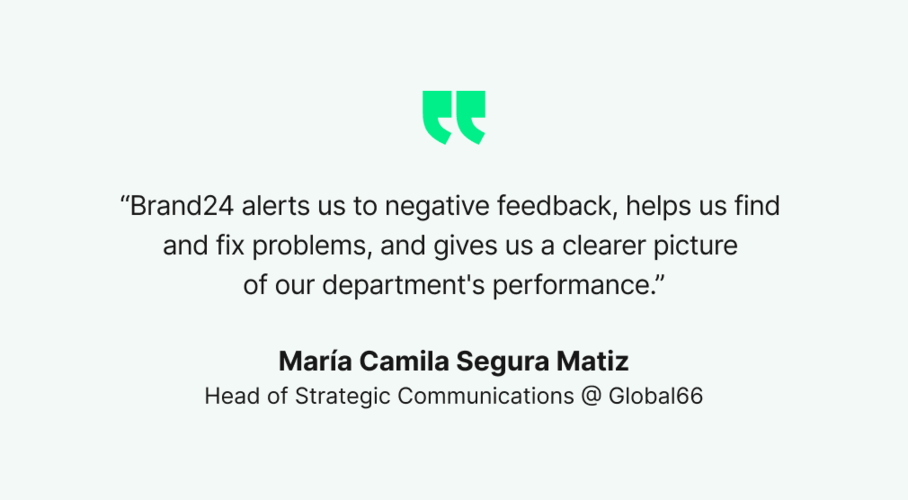
- Executive & leadership teams
For decision-makers, media intelligence delivers the big picture:
- Is our latest product launch resonating with the public?
- What are customers, partners, and the press saying?
- Are we ahead or behind competitors in key conversations?
- Which markets or demographics are gaining traction?
- How is the media landscape changing?
Esteja um passo à frente!
As you can see, media intelligence is quite advanced and very versatile.
And that’s the best thing about it!
I mean…
Why invest in many data collection and media analysis tools when you can have everything your company needs in one place?
What is media analytics?
Media analytics is the process of measuring and evaluating how your content, brand, or messaging performs across different media channels.
It’s all about the numbers. It helps you understand what’s working, what’s not, and where to improve.
But doesn’t dig into WHY it is that way.
While media intelligence focuses on broader strategy and emerging trends, media analytics drills down into performance metrics.
It answers questions like:
- How much media coverage did we receive?
- Which social media posts had the highest engagement?
- What was the reach of our latest campaign?
- How did our press release perform in different outlets?
Try Media Intelligence now!
Media analytics is crucial for tracking ROI, optimizing campaigns, and reporting results to stakeholders.
Especially in enterprise environments where accountability and performance data matter at every level.
It can include many different methods. Let me briefly introduce you to the most important ones.
Key features of media analytics:
- Reach & impressions tracking
Conduct data analysis on how many people saw your content across different platforms. - Métricas de engajamento
Track interactions such as likes, shares, comments, clicks, and video views to understand what content resonates with your audience. - O volume de mentions
Count the number of brand mentions over time to evaluate campaign impact, product launches, or PR efforts. - Dados demográficos do público
Understand who’s engaging with your content based on location, language, age group, or interests.
Know how your performance changes!
Media Intelligence vs Media Analytics: What’s the real difference?
Media analytics and media intelligence are closely related, but they serve different purposes.
- Media analytics focuses on tracking and measuring how media content performs, so things like reach, engagement, and impressions.
- Media intelligence goes a step further by collecting and analyzing media data to uncover patterns, trends, and insights that support strategic decision-making.
Em resumo, media intelligence builds on analytics by adding context, identifying emerging topics, and even predicting what’s coming next.
Here’s a detailed comparison:
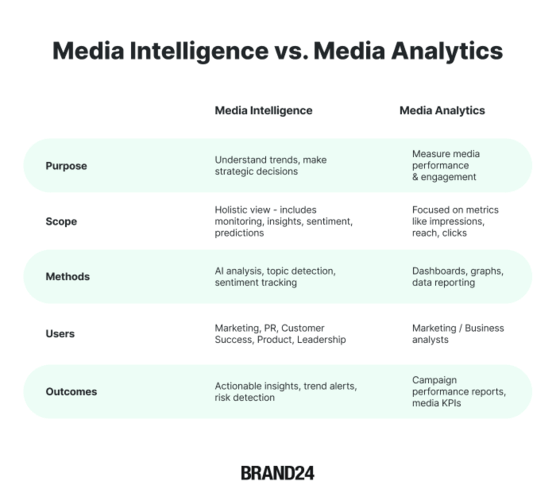
5 Reasons why media intelligence is important
Once you set up a global media intelligence solution, you get access to many meaningful insights.
Try Media Intelligence now!
What exactly?
Here’s a list of benefits of using media intelligence:
- Geração de leads
By monitoring what your target audience talks about, media intelligence helps you spot new opportunities. It’s a great way to discover intent signals and start conversations that can later become sales. - Align your whole team
Whether you’re in PR, marketing, or leadership – everyone benefits from the same live data. One source of truth = less guessing and better strategy. - Competitor advantage
When you track how your competitors are being mentioned in the media, what strategies they’re using, and how customers react, you gain insights that help you position better, act faster, and spot gaps in the market. - Monitoramento da marca
You know exactly what people talk about you across news outlets, social media platforms, forums, and beyond. It helps to detect issues early, respond with context, and keep your reputation healthy. - Detecção de influenciadores
You can easily find people that are already talking about your brand, or your competitors. It’s a powerful way to find authentic influencer partnerships backed by data, not guesswork. - Identificação de tendências
Media intelligence tools help you spot trending topics and rising conversations. This lets you adjust your content, campaigns, or product ideas to match what people are actually interested in.
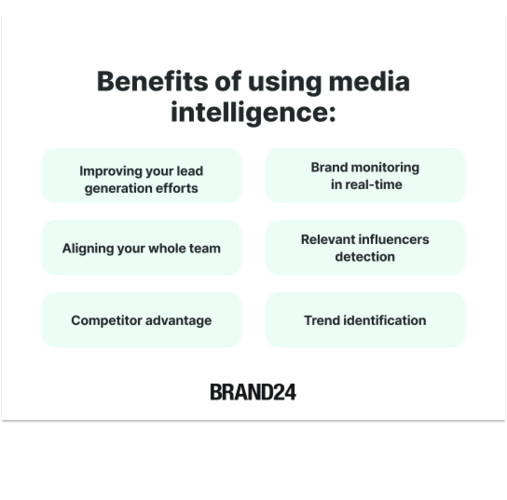
How does media intelligence work?
01 Collect data
The first step in any media intelligence process is gathering the right data.
The goal is to capture a full picture of your brand’s presence across digital and traditional media.
Here’s what you should collect:
- Número total de mentions
- Sentiment breakdown (positive, negative, neutral)
- Reach and AVE (Advertising Value Equivalent)
- Social and non-social media performance data
- Comments, shares, and user reactions
- Conteúdo gerado pelo usuário
- Compartilhamento de voz
Monitore o desempenho de sua marca!
Let’s take a look at it based on real example – IKEA project.
I checked their data for the last 30 days and it turned out that:
- They received over 110k mentions, reaching 782M people.
- Positive sentiment made up a strong share (38k).
- Social media engagement is high with 20M interactions e 95k user-generated posts.
Here’s what the summary looks like directly in the Brand24 dashboard:
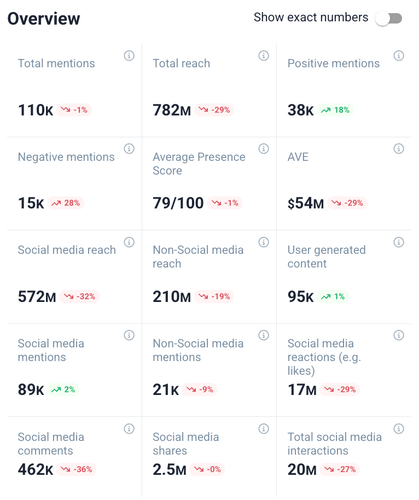
This kind of detailed data forms the foundation for deeper analysis and… more informed decisions.
Get your data overview!
02 Filter the data
But let’s be honest:
Monitoring all the metrics above can quickly get overwhelming.
É por isso que it’s crucial to define which data points truly matter for your business goals and focus on those.
Most media intelligence tools, including Brand24, make this easy by offering smart filtering options to help you cut through the noise.
Brand24, for example, lets you filter data by:
- Sentimento (positive, negative, or neutral mentions)
- Platform type (separate social media from blogs, forums, and news sites)
- Reach and influence score (focus on high-impact mentions only)
- Language or location (track specific markets or regions)
- Palavra-chave (monitor specific campaigns, product lines, or competitors)
- Date ranges (narrow down your view to specific time frames)
With the right filters in place, you can quickly zero in on what matters most.
Whether it’s a product issue gaining traction, a sudden spike in negative sentiment, or a campaign that’s getting great reactions in a key market.
Know what people think about your updates and products!
So, as IKEA is about to launch their collab with Gustaf Westman, they can easily filter the data by “Gustaf Westman” keyword to analyze its performance:
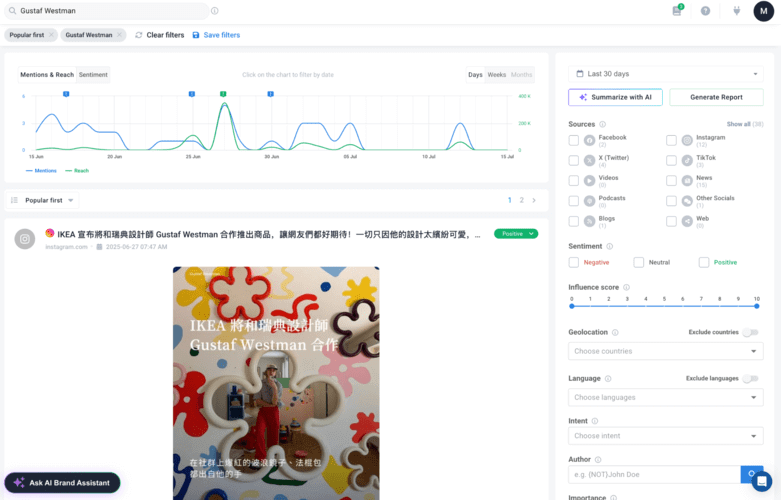
And access the filtered analysis:
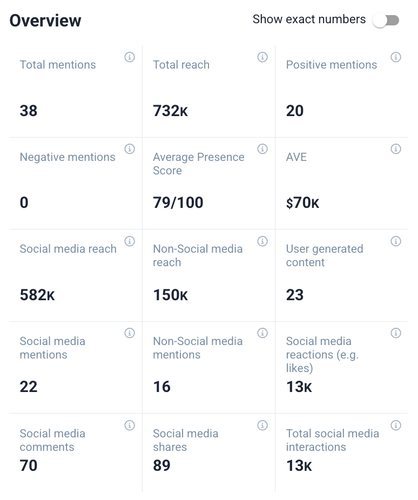
03 Analyze data or use AI
Once your data is filtered, it’s time to turn it into insights.
You can dig in manually by reviewing mentions, comparing sentiment, tracking spikes… or let AI do the heavy lifting for you.
I like to use Assistente de marca com IA for this part.
It makes the analysis process much faster and easier.
Acesse o AI Brand Assistant!
Instead of scrolling through thousands of mentions, AI scans the data for you and delivers various analyses like:
- Summaries of your performance, key trends, and activity
- Changes in the market
- Reasons behind unusual spikes in volume or sentiment
- Suggestions for next steps or content directions
- Competitive analysis regarding specific products, campaigns, and more
Let’s see how it works on a real example!
I asked AI Brand Assistant for an analysis regarding collabs with designers.
Here’s what I got:
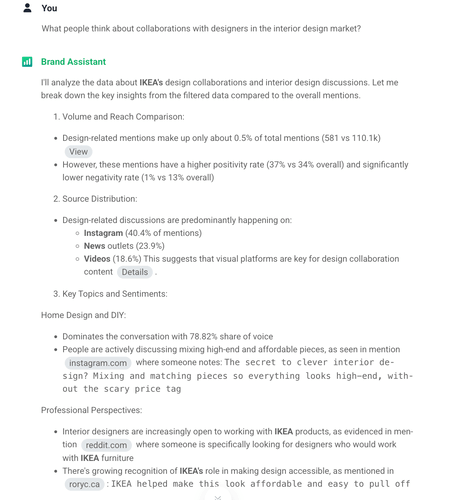
As you can see, AI can provide actionable insights within seconds.
While it does the analysis, you can focus on what really matters – strategy.
Try Media Intelligence now!
Definitely worth giving a try!
04 Pay attention to topics
Yep, looking at the big numbers is useful.
But they don’t tell you PORQUE people are talking about your brand.
To really understand what’s driving the conversation, you need to look at specific topics.
Media intelligence can help with that!
For example, Brand24 groups mentions into themes, so you can quickly see what people are actually talking about.
When you break things down by topic, you can spot:
- What gets people talking
- Which messages hit the mark (and which don’t)
- How people feel about different parts of your brand
- Where does it make sense to focus your content or communication next
It’s a simple way to turn noise into insights.
Check the context behind your brand!
Here’s what the Topic Analysis Tab looks like:
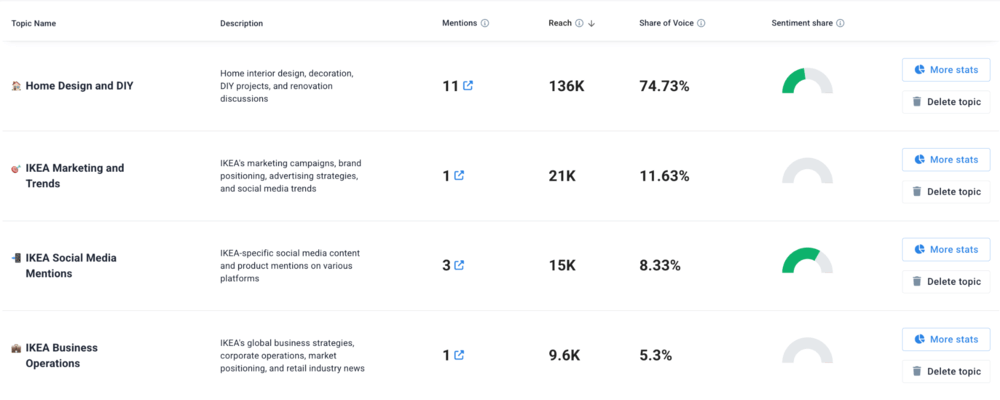
In IKEA’s case, it’s no surprise that Home Design and DIY dominated.
That’s their bread and butter.
It took up nearly 75% of the share of voice.
But here’s what caught my eye: topics like Marketing & Trends, Business Operationsou mesmo Mídia social barely made a dent.
That’s surprising, considering how active and creative IKEA is in these areas. They run global campaigns, launch bold ideas, and show up on almost every social platform.
And yet… not many people talk about that side of the brand.
To me, that’s a missed opportunity.
If most of the talk sticks to products and home hacks, maybe it’s time to boost storytelling around IKEA’s brand strategy, values, or behind-the-scenes work.
Topic analysis like this helps you spot where your message isn’t landing and gives you ideas on where to focus next.
Make sure never to miss an opportunity for growth!
05 Set up reporting
Once you’ve got your insights, it’s time to share them.
Reporting really matters in bigger teams. It keeps everyone on the same page and helps turn data into action.
The good news? AI tools make it super easy.
For example, in Brand24, you can:
- Create automatic reports (daily, weekly, or whenever you need)
- Choose exactly what data to include
- Share it as a link or download a PDF, Excel, or infographic
- Adjust the format and data for different teams – PR, marketing, execs, you name it
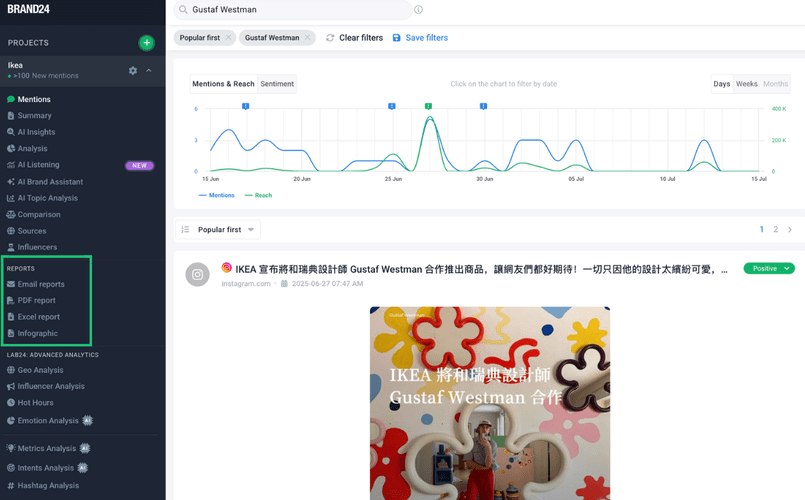
Instead of spending hours building slides or digging through dashboards, you get clean, clear reports ready to go.
It’s a huge time-saver & it helps you show the real value of media insights.
Set up reporting for your brand!
Here’s what a shareable report looks like:
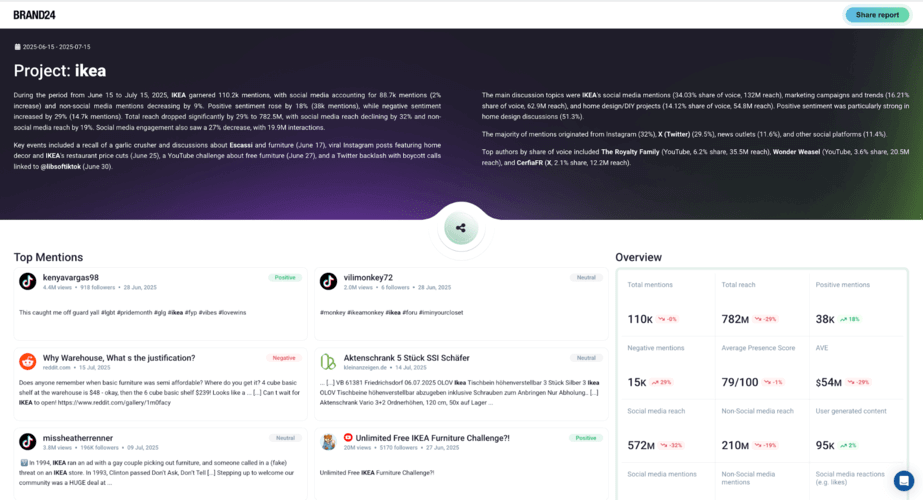
06 Tailor your media intelligence strategy
All the data in the world won’t help if you don’t do something with it.
The final step is simple:
Take what you’ve learned and apply it to your strategy.
That might mean adjusting your messaging, shifting focus to a new trend, rethinking your content plan, or responding to a growing issue before it turns into a problem.
And it’s not just a one-time thing.
The best brands use media intelligence continuously.
Automate data analysis!
They keep tracking key metrics, analyzing new conversations, and fine-tuning their approach week by week.
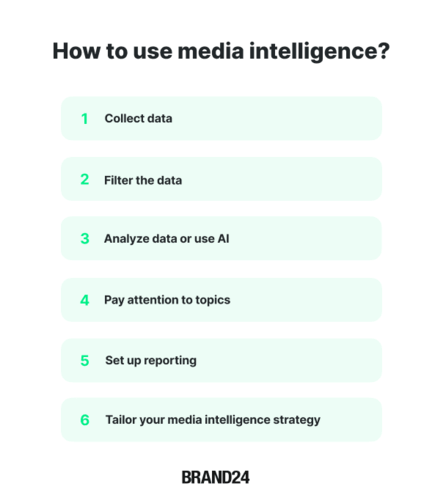
PERGUNTAS FREQUENTES
What is a media intelligence analysis?
Media intelligence is the process of collecting, analyzing, and leveraging escuta social dados from news media, social platforms, blogs, forums, and other online content to gain actionable insights.
It combines media monitoring, natural language processing (NLP), sentiment analysis, and data visualization to help brands:
- Track mentions and reputação da marca
- Compreender o sentimento do público
- Identify trends and emerging issues
- Benchmark competitors
- Inform PR and marketing strategy
Try Media Intelligence now!
How is media intelligence different from media monitoring?
While often used interchangeably, monitoramento de mídia e media intelligence serve different purposes:
- Monitoramento de mídia involves tracking brand mentions, keywords, or topics across various channels like news, blogs, and social media.
- Media intelligence goes further by analyzing that data for trends, sentiment, context, and strategic value.
Get insights about emerging trends!
How is media intelligence different from media research?
While both involve studying media content, they differ in scope, tools, and intent:
- Media research is typically academic or campaign-driven. It focuses on how media affects audiences or measures media consumption patterns, often using controlled studies or surveys.
- Media intelligence is continuous, real-time, and operational. It uses machine learning, natural language processing (NLP), and big data techniques to analyze large volumes of media for business or competitive advantage.
Conduct market research without extra hassle!
How to measure the success of media intelligence efforts?
Measuring media intelligence ROI (return on investment) depends on your goals, but common success metrics include:
- Compartilhamento de voz (SOV): How your media presence compares to competitors.
- Sentiment analysis trends: Changes in public perception over time.
- Media reach and engagement: Number of impressions, clicks, or shares.
- Crisis detection speed: How quickly issues are identified and addressed.
Monitore o desempenho de sua marca!
How does media intelligence help in decision-making?
Media intelligence supports smarter, faster, and more informed decision-making by transforming unstructured media data into actionable insights.
It enables organizations to anticipate trends, mitigate risks, and optimize strategies across departments.
Get one tool for every department of your company!
What features should I look for in a media intelligence platform?
Key features you should prioritize:
- Multichannel tracking (news, social, blogs)
- Real-time alerts and dashboards
- AI-powered analysis
- Custom reporting and exportable data
- Colaboração da equipe
- Integrations with BI tools
Choose them based on your team’s strategic goals and technical needs.
That’s it, you’re ready for your media intelligence journey! Comece com uma avaliação Brand24 and get instant insights!
Artigos relacionados

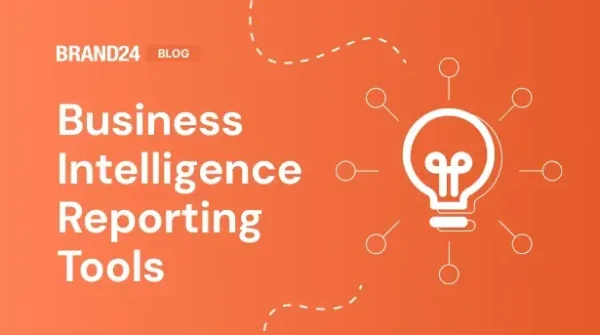
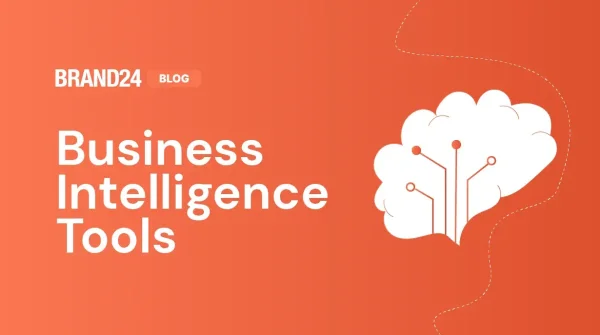
![9 etapas para uma estratégia sólida de reconhecimento da marca [2025]](https://brand24.com/blog/app/uploads/2020/12/15-The-ultimate-guide-to-brand-awareness-1400x660x2.png)
